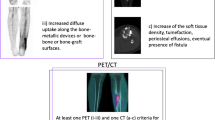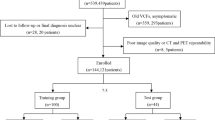Abstract
Objective
To evaluate the efficacy of F-18-fluoro-2-deoxy-D-glucose positron emission tomography/computed tomography (FDG PET/CT) in differentiating malignant from benign pathologic fractures.
Materials and methods
F-18 FDG PET/CT was performed on 34 patients with pathologic fractures between May 2004 and June 2007. Fractures were located in tubular bones (26), in the pelvis (six), in the spine (one) and in a rib (one). The FDG uptake pattern at the fracture site was described, whether FDG uptake occurred in the marrow or cortex and soft tissue. Maximum standardized uptake values (SUVmax, the largest value at the region of interest) were measured at the fracture site, including cortical bone, bone marrow and soft tissue. As a reference standard, biopsy was used for 12 patients and clinical follow-up for 22 patients. Sensitivity, specificity and diagnostic accuracy of PET/CT were calculated.
Results
There were 19 malignant and 15 benign fractures. In the malignant fractures, PET/CT demonstrated high (mean SUVmax 12.0, range 4.3 to 45.7) F-18 FDG uptake in bone marrow in most cases (17 of 19). In benign fractures, there was low FDG uptake (mean SUVmax 2.9, range 0.6 to 5.5) within cortical bone or adjacent soft tissue around the fracture, rarely in the marrow. There were significant differences in the pattern of intramedullary FDG uptake (P < 0.001) and in the mean SUVmax (P < 0.01) between malignant and benign fractures. The sensitivity, specificity and diagnostic accuracy of F-18 FDG PET/CT were 89.5%, 86.7% and 88.2%, respectively, with a cut-off SUVmax set at 4.7. The time interval between fracture and PET/CT did not significantly influence FDG uptake at the fracture site.
Conclusion
F-18 FDG PET/CT reliably differentiated between malignant and benign fractures based on the SUVmax and based on medullary uptake, which was characteristic for malignant fractures.




Similar content being viewed by others
References
Gambhir SS. Molecular imaging of cancer with positron emission tomography. Nat Rev Cancer 2002; 2(9): 683–693.
Schwarzbach MH, Dimitrakopoulou-Strauss A, Willeke F, et al. Clinical value of [18-F] fluorodeoxyglucose positron emission tomography imaging in soft tissue sarcomas. Ann Surg 2000; 231(3): 380–386.
Wu H, Dimitrakopoulou-Strauss A, Heichel TO, et al. Quantitative evaluation of skeletal tumours with dynamic FDG PET: SUVmax in comparison to Patlak analysis. Eur J Nucl Med 2001; 28(6): 704–710.
Taira AV, Herfkens RJ, Gambhir SS, Quon A. Detection of bone metastases: assessment of integrated FDG PET/CT imaging. Radiology 2007; 243(1): 204–211.
Loft A, Berthelsen AK, Roed H, et al. The diagnostic value of PET/CT scanning in patients with cervical cancer: a prospective study. Gynecol Oncol 2007; 106(1): 29–34.
Iagaru A, Quon A, McDougall IR, Gambhir SS. F-18 FDG PET/CT evaluation of osseous and soft tissue sarcomas. Clin Nucl Med 2006; 31(12): 754–760.
McCarville MB, Christie R, Daw NC, Spunt SL, Kaste SC. PET/CT in the evaluation of childhood sarcomas. AJR Am J Roentgenol 2005; 184(4): 1293–1304.
Paul R, Ahonen A, Virtama P, Aho A, Ekfors T. F-18 fluorodeoxyglucose: its potential in differentiating between stress fracture and neoplasia. Clin Nucl Med 1989; 14(12): 906–908.
Schmitz A, Risse JH, Textor J, et al. FDG-PET Findings of vertebral compression fractures in osteoporosis: preliminary results. Osteoporos Int 2002; 13(9): 755–761.
Shon IH, Fogelman I. F-18 FDG positron emission tomography and benign fractures. Clin Nucl Med 2003; 28(3): 171–175.
Kato K, Aoki J, Endo K. Utility of FDG-PET in differential diagnosis of benign and malignant fractures in acute to subacute phase. Ann Nucl Med 2003; 17(1): 41–46.
Katzel JA, Heiba SI. PET/CT F-18 FDG scan accurately identifies osteoporotic fractures in a patient with known metastatic colorectal cancer. Clin Nucl Med 2005; 30(10): 651–654.
Tsuchida T, Kosaka N, Sugimoto K, Itoh H. Sacral insufficiency fracture detected by FDG-PET/CT: report of 2 cases. Ann Nucl Med 2006; 20(6): 445–448.
Aoki J, Watanabe H, Shinozaki T, et al. FDG PET of primary benign and malignant bone tumors: standardized uptake value in 52 lesions. Radiology 2001; 219(3): 774–777.
Meyer M, Gast T, Raja S, Hubner K. Increased F-18 FDG accumulation in an acute fracture. Clin Nucl Med 1994; 19(1): 13–14.
Ravenel JG, Gordon LL, Pope TL, Reed CE. FDG-PET uptake in occult acute pelvic fracture. Skeletal Radiol 2004; 33(2): 99–101.
Zhuang H, Sam JW, Chacko TK, et al. Rapid normalization of osseous FDG uptake following traumatic or surgical fractures. Eur J Nucl Med Mol Imaging 2003; 30(8): 1096–1103.
Author information
Authors and Affiliations
Corresponding author
Additional information
This research was supported by the Yeungnam University research grants in 2007.
Rights and permissions
About this article
Cite this article
Shin, DS., Shon, OJ., Byun, SJ. et al. Differentiation between malignant and benign pathologic fractures with F-18-fluoro-2-deoxy-D-glucose positron emission tomography/computed tomography. Skeletal Radiol 37, 415–421 (2008). https://doi.org/10.1007/s00256-008-0462-3
Received:
Revised:
Accepted:
Published:
Issue Date:
DOI: https://doi.org/10.1007/s00256-008-0462-3




